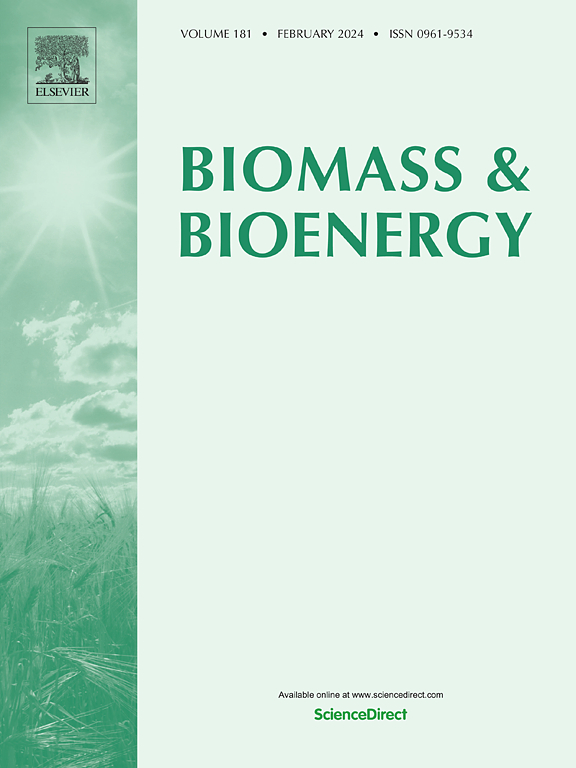未经处理的竹生物炭作为可持续锂离子电池的负极材料
IF 5.8
2区 生物学
Q1 AGRICULTURAL ENGINEERING
引用次数: 0
摘要
生物炭是一种通过热解从木质纤维素生物质中提取的富含碳的材料,由于其可持续的采购、制造和良好的电化学性能,正被考虑用于锂离子电池(LIB)。生物炭基阳极是传统材料的绿色替代品,有可能降低LIB生产的环境和财务成本。最大限度地降低成本和简化锂电池的制造过程,推动了新的可扩展的植物产品生产的发展,以创造更环保的锂电池阳极。本研究通过优化的慢热解路线,在800℃(B800)和1000℃(B1000)两种温度下制备竹基生物炭(BCs),并将其用作锂离子电池阳极。与B1000相比,B800具有更高的d间距(d002 = 0.3657 nm)和石墨晶尺寸(La = 13.8 nm),更小的孔径(38 Å)和更高的表面积(310 m2/g),以及更高的以碳为中心的永久自由基(PFRs)浓度(1.85 × 1018自旋/g)。虽然B1000的导电性略高于B800,但由于PFRs的存在,B800的物理化学性质可以增强假石墨结构的锂化,并促进Li+离子的还原。使用B800的半电池LIB在C/5下的可逆容量约为250 mA h/g,长期稳定性高达450次循环。这项研究强调了竹基生物炭作为下一代高性能锂离子电池可行且环保的阳极材料的潜力。本文章由计算机程序翻译,如有差异,请以英文原文为准。

Untreated bamboo biochar as anode material for sustainable lithium ion batteries
Biochar, a carbon-rich material derived from lignocellulose biomass through pyrolysis, is being considered for lithium-ion battery (LIB) applications due to its sustainable sourcing, manufacturing, and favourable electrochemical properties. A biochar-based anode is a greener alternative to conventional materials, potentially reducing the environmental and financial costs of LIB production. Minimizing cost and simplifying the manufacturing process for LIBs drive the development of new scalable production of plant-based products to create greener anodes for lithium batteries. In this work, bamboo-based biochar (BCs) was prepared through an optimized slow pyrolysis route with two thermal treatments at 800 °C (B800) and 1000 °C (B1000), and used as a LIB anode. Compared to B1000, B800 presented higher d-spacing (d002 = 0.3657 nm) and graphitic crystallite size (La = 13.8 nm), smaller pore sizes (38 Å) with higher surface area (310 m2/g), and a higher concentration of permanent free radicals (PFRs) centered on the carbon (1.85 × 1018 spin/g). Although B1000 is slightly more conductive than B800, the physicochemical properties of B800 could enhance the lithiation of the pseudographitic structures and facilitate the reduction of Li+ ions due to the presence of PFRs. The half-cell LIB using B800 presented a reversible capacity of about 250 mA h/g at C/5 and long-term stability up to 450 cycles. This study highlights the potential of bamboo-based biochar as a viable and environmentally friendly anode material for the next generation of high-performance LIBs.
求助全文
通过发布文献求助,成功后即可免费获取论文全文。
去求助
来源期刊

Biomass & Bioenergy
工程技术-能源与燃料
CiteScore
11.50
自引率
3.30%
发文量
258
审稿时长
60 days
期刊介绍:
Biomass & Bioenergy is an international journal publishing original research papers and short communications, review articles and case studies on biological resources, chemical and biological processes, and biomass products for new renewable sources of energy and materials.
The scope of the journal extends to the environmental, management and economic aspects of biomass and bioenergy.
Key areas covered by the journal:
• Biomass: sources, energy crop production processes, genetic improvements, composition. Please note that research on these biomass subjects must be linked directly to bioenergy generation.
• Biological Residues: residues/rests from agricultural production, forestry and plantations (palm, sugar etc), processing industries, and municipal sources (MSW). Papers on the use of biomass residues through innovative processes/technological novelty and/or consideration of feedstock/system sustainability (or unsustainability) are welcomed. However waste treatment processes and pollution control or mitigation which are only tangentially related to bioenergy are not in the scope of the journal, as they are more suited to publications in the environmental arena. Papers that describe conventional waste streams (ie well described in existing literature) that do not empirically address ''new'' added value from the process are not suitable for submission to the journal.
• Bioenergy Processes: fermentations, thermochemical conversions, liquid and gaseous fuels, and petrochemical substitutes
• Bioenergy Utilization: direct combustion, gasification, electricity production, chemical processes, and by-product remediation
• Biomass and the Environment: carbon cycle, the net energy efficiency of bioenergy systems, assessment of sustainability, and biodiversity issues.
 求助内容:
求助内容: 应助结果提醒方式:
应助结果提醒方式:


